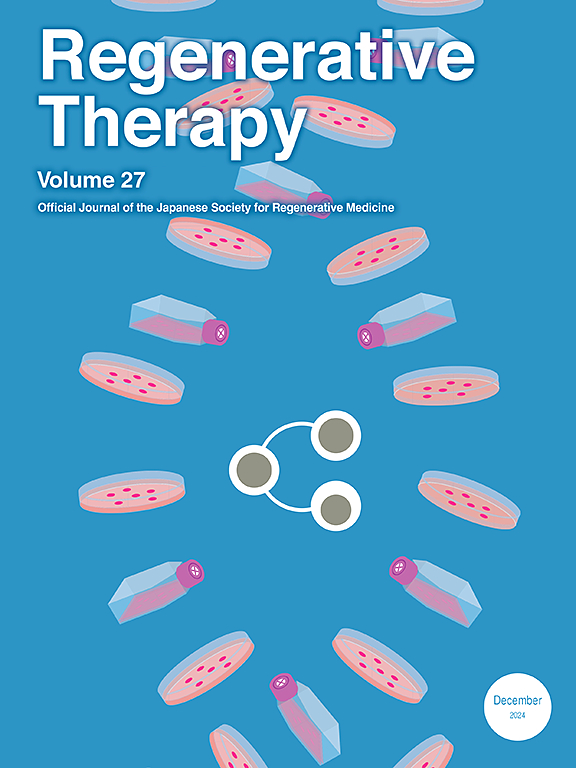髋关节骨关节炎的自体脂肪来源干细胞关节内注射:纵向治疗轨迹和预后因素
IF 3.5
3区 环境科学与生态学
Q3 CELL & TISSUE ENGINEERING
引用次数: 0
摘要
关于间充质干细胞在改善髋关节骨关节炎(OA)患者髋关节功能方面的有效性的证据仍然不一致。因此,我们的目的是在整体队列和按OA严重程度分层的队列中,估计髋关节OA患者关节内给予自体脂肪源性干细胞(ASCs)后治疗效果的纵向轨迹,并探讨治疗结果的预后因素。方法本回顾性研究纳入了在2020年至2023年治疗前接受磁共振成像(MRI)检查的成年髋关节OA患者。所有患者均接受关节内ASC给药。主要结果是治疗后1、3、6个月日本骨科协会髋关节疾病评估问卷(JHEQ)的总分。使用线性混合效应模型来估计所有患者JHEQ总分随时间的边际预测变化,并比较根据OA严重程度分类的亚组之间的这些变化。此外,包括MRI结果的模型被用来探索潜在的预后因素。结果我们在129例患者中确定了168个髋关节。在对所有患者的分析中,与基线相比,JHEQ总分在治疗后1、3和6个月显著增加。在混合效应分析中,JHEQ总分从基线到6个月随访的预测变化为10.6分(95%置信区间8.3 ~ 12.8),随着时间的推移呈增加趋势。治疗后观察OA严重程度对JHEQ总分的影响随时间的变化(P = 0.016)。预后分析显示,中度髋关节炎患者治疗后JHEQ总分高于轻度髋关节炎患者(P = 0.028)。治疗后女性患者JHEQ总分高于男性患者(P = 0.025)。治疗后,圆韧带异常与较低的JHEQ总分相关(P = 0.011)。结论:关节内ASC治疗在6个月内提高了患者报告的结果,在髋部OA严重程度上观察到差异。女性和中度髋关节骨关节炎是ASC治疗后患者报告结果的积极预后因素,而韧带异常是负面预后因素。这些发现可用于告知患者和临床医生预期的治疗过程,并帮助临床决策使用关节内ASC治疗髋关节OA。本文章由计算机程序翻译,如有差异,请以英文原文为准。
Intra-articular administration of autologous adipose-derived stem cells in hip osteoarthritis: Longitudinal treatment trajectories and prognostic factors
Introduction
Evidence regarding the effectiveness of mesenchymal stem cells in improving hip function in patients with hip osteoarthritis (OA) remains inconsistent. Therefore, we aimed to estimate the longitudinal trajectories of treatment effects in individuals with hip OA following intra-articular administration of autologous adipose-derived stem cells (ASCs), both in the overall cohort and the cohort stratified by OA severity, and to explore the prognostic factors of treatment outcomes.
Methods
This retrospective study included adults with hip OA who underwent magnetic resonance imaging (MRI) before treatment between 2020 and 2023. All patients underwent intra-articular ASC administration. The primary outcomes were the total scores on the Japanese Orthopaedic Association Hip Disease Evaluation Questionnaire (JHEQ) at 1, 3, and 6 months after treatment. A linear mixed-effects model was used to estimate the marginally predicted JHEQ total score changes over time for all patients and compare these changes among subgroups categorized according to OA severity. Furthermore, models that included MRI findings were used to explore potential prognostic factors.
Results
We identified 168 hips in 129 patients. In the analysis of all patients, the JHEQ total scores significantly increased at 1, 3, and 6 months after treatment compared with baseline. In the mixed-effects analysis, the predicted change in the JHEQ total score from the baseline to the 6-month follow-up was 10.6 points (95 % confidence interval, 8.3 to 12.8), with an increasing trend over time. The effect modification by OA severity on the JHEQ total score was observed over time after treatment (P = 0.016). Prognostic analysis revealed that patients with moderate hip OA had higher JHEQ total scores after treatment than those with mild hip OA (P = 0.028). Additionally, female patients had higher JHEQ total scores after treatment than male patients (P = 0.025). The presence of ligamentum teres abnormalities was associated with low JHEQ total scores after treatment (P = 0.011).
Conclusions
Intra-articular ASC treatment enhanced patient-reported outcomes over 6 months, with differences observed across hip OA severities. Female sex and moderate hip OA were positive prognostic factors, whereas ligamentum teres abnormalities were negative prognostic factors for patient-reported outcomes after ASC treatment. These findings can be used to inform patients and clinicians about the expected course of treatment and aid clinical decision-making regarding the use of intra-articular ASC treatment for hip OA.
求助全文
通过发布文献求助,成功后即可免费获取论文全文。
去求助
来源期刊

Regenerative Therapy
Engineering-Biomedical Engineering
CiteScore
6.00
自引率
2.30%
发文量
106
审稿时长
49 days
期刊介绍:
Regenerative Therapy is the official peer-reviewed online journal of the Japanese Society for Regenerative Medicine.
Regenerative Therapy is a multidisciplinary journal that publishes original articles and reviews of basic research, clinical translation, industrial development, and regulatory issues focusing on stem cell biology, tissue engineering, and regenerative medicine.
 求助内容:
求助内容: 应助结果提醒方式:
应助结果提醒方式:


